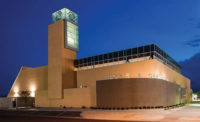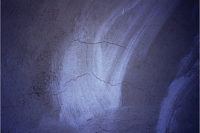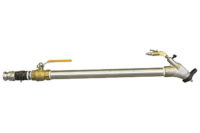How to Treat Efflorescence

After a severe rainstorm, efflorescence bloomed on this home.

Efflorescence leeching from a cracked stucco wall. This is a retaining wall with no weep holes. Later, weep holes were added and the wall refinished.

Excessive amounts of water used to smooth a trowel finish can lead to efflorescence.







In the Southwest, we started springtime in early February. During that time, there were reports of severe snowfall in the Northeast and about how Punxsutawney Phil decided to just stay in his warm den. Arizona was chilly, hitting temps in the low ’50s—brrr. So, for the rest of the nation, winter stuck it out as long as possible. But now that it is April, we all are enjoying our spring or spring-like weather. Springtime is the season of flowers, Mother Nature’s first smile, warming the land and our hearts. Ah yes, springtime …
For us EIFS and stucco professionals, springtime can wreak havoc on our cement based claddings. You see, we have our own spring flower of sorts, a blooming in the cement we call efflorescence. Now you all know me as a proper pronunciation kind of guy (no EFES) and the word efflorescence falls into one of my target word categories. It isn’t effervescence, that’s what cleans dentures, nor is it emmeresence, efference, or emmnnmm … essints, all non-words. Efflorescence is the surface presence of soluble salts contained within cement, lime, sand and water. These salts can be carried to the surface via moisture to the outside or dry area, and be left behind as a powdery film once the moisture evaporates. Efflorescence also comes in a variety of colors; white, yellow, green and tan.
Let’s take a somewhat technical look at efflorescence. When efflorescence occurs, there is a sudden loss of water of a hydrated salt component. The aqueous salt is carried to the surface where the water evaporates, and then the salts effloresce, leaving the surfaces with a powdery appearance. The salts are principally alkalis made up of sodium sulfates (Na3S04) and potassium sulfates (K2S04). These naturally exist in cement or lime or sand, and in areas with high mineral content in the water, can exist within the water too. Now that you know what efflorescence is, you should know there are three conditions that must exist to have efflorescence occur or be present:
- There must be water-soluble salts present somewhere in the materials.
- There must be sufficient moisture in the wall to render the salts into a soluble solution.
- There must be a path for the soluble salts to migrate through to the surface where the moisture can evaporate, leaving the crystallized salts on the surface.
EIFS Basecoats
EIFS basecoats don’t usually have many issues with efflorescence. Because there is a high ratio of acrylic to cement content, the salts become encased by the acrylics and don’t have a path to the surface. But, that doesn’t mean it is efflorescence free. With EIFS basecoats there is a chemical reaction between the cement and acrylic, a curing of sorts, which takes about 24 hours to complete. The curing process allows hydration of the cement and the formation of polymer chains, leaving a dense, albeit thin, protective coating. Once fully cured, there is no migration of water within the coating, only some vapor transmission which typically isn’t enough for efflorescence to occur. If moisture is allowed to get onto an EIFS basecoat before the curing is complete, then yes, efflorescence can occur.
Stucco Basecoats
Like masonry and concrete, stucco is susceptible to efflorescence if not finished properly. Let’s assume that there is a given amount of salt and mineral content in the components of a stucco mix. It is springtime and the nighttime temps are cool and laden with moisture. The daytime temps surge by 40 to 50 degrees during the day then fall back at night. I have just described the perfect conditions for efflorescence to occur. Remember that hydration must occur in cement, which is the cure of the cladding where crystalline formations contribute to the density of the cement layers. Until hydration has occurred in the stucco, there are thousands of little passageways through the cladding known as capillary tubes. It is through these tubes that soluble salts are carried to the surface as the warm sun evaporates the liquid within the cladding.
Prevention
EIFS basecoats are the easiest cladding in which to prevent efflorescence. During the springtime, the basic rule of thumb is to make sure no wet basecoat is left to dry overnight. If one has to leave a wet wall then cover the elevation with plastic (tenting) to slow the evaporation during the curing process. If efflorescence does occur know that it must be removed before applying another coat of anything.
In stucco, it is easy to restrict the occurrence of efflorescence. You all have heard it from me before, hard float the wall and wet cure. Do not use a sponge float it will only exacerbate the occurrence. Hard floating densifies the stucco, collapsing the capillary tubes, and wet curing allows the hydration process to fill the rest of the microscopic voids. Another benefit to wet curing is that in the event of hairline or minor cracking, the addition of moisture can promote what is known as autogenous healing. Simply, that is where the minerals and salts within the mix are carried through the crack and get stuck along the way plugging up the passage. Don’t take my word for it, visit the Aachen Institute of Germany’s Web site. They have done the tests, they have the data proving autogenous healing exists.
Eradication
So you have efflorescence on the wall. Even if one has given the utmost of care, the duest of diligence, the closest of attention, efflorescence can still pop up. So, what is a person to do? First, use a brush or push broom to sweep the bulk of the powder off of the dry surface. Second, you will need to stop more bloom via neutralization. There are a host of commercial grade efflorescence removers, some provided by stucco additive manufacturers. These manufacturers also provide detailed instructions, so follow them exactly. The efflorescence removers are acid based, and recalling from my high school science class, neutralize alkali (aka efflorescence). This may take numerous applications so after you rinse, let the wall dry, and repeat as required. (Efflorescence doesn’t show up on a wet wall.) If the efflorescence is really bad you may need to scrub a bit while the remover is activating. Don’t be real aggressive with the scrubbing, it can wear off a finish or cause discoloration.
Tip: Do not apply any acid-based material to a dry wall. It will stain the cement, and the finish, guaranteed. Always wet the wall prior to applying acids. Do not let the acid touch any other finished surface either. And of course, always wear proper protection and be mindful of where the rinse water is going.
Once the efflorescence is neutralized, or has run its course, the blooming event stops. This may occur even without any treatment. When efflorescence is being neutralized, the “tell” is a hissing and slight foaming meaning the acid is neutralizing the alkali; non-action means you have completed the neutralization. If you are in a sensitive area, or concerned about the caustic nature of the removers, just use vinegar. It is less harmful, heck you can drink it, but can take more passes to work effectively. Vinegar is my choice of efflorescence remover. Like the removers, don’t apply vinegar to a dry wall surface, it too will stain.
Efflorescence has been around for a very long time. It is visible on many cement or masonry structures, sidewalks, stone facades, heck even in dirt. Its presence doesn’t mean the products are faulty or that application was flawed. Sometimes, it is just what it is—Mother Nature bringing flowers.
Looking for a reprint of this article?
From high-res PDFs to custom plaques, order your copy today!













